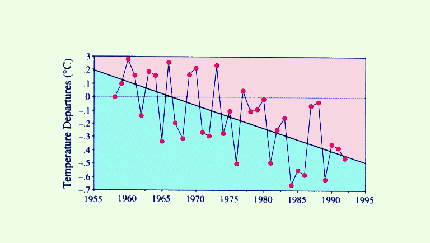| Is Climate Changing? |

|
| Is Climate Changing? |

|
The question "Is climate changing?" is a no brainer. The question "What is causing our climate change?" is were the gray matter helps. The illustration above is from Jim Angell's analyses of temperature records from balloon ascents and it shows the changes in temperature of the atmosphere between 30,000 and 53,000 feet. It has been getting colder up there. Between the late 1950s and the early 1990s it has cooled some 0.7 C. Now it is real cold up there anyway. Minus 50 C is no big deal and the -0.7 C doesn't seem like much but by global temperature standards it is a lot. The GCMs charged with extra CO2 tell us that the upper atmosphere should cool and the lower atmosphere should warm. The problem is that the models say it should cool above 53,000 feet and warm below this altitude. The cooling since the 1950s been down to a sub-747 cruise altitude. Has the climate of the upper atmosphere changed? You bet! Is the observed cooling a signature of CO2 global warming? Could be, perhaps and maybe.
Some blamers has cast chlorofluorocarbon-ozone-depletion stones at this high altitude cooling. The problem with this morsel of blame is that there just wasn't much CFC up there for the first decade of the Angell record.
We might ask "In the absence of excess-CO2 and CFCs would the temperature of the upper atmosphere remain constant.?" I don't know any climatologists who would sign on to an it-doesn't-have-any-natural-variation hypothesis. Most of us believe our atmosphere is dynamic and experieces change on all climate time scales. We follow the motherhood and apple pie climate hypothesis.
Angell, J. K. (1994). Global, hemispheric, and zonal temperature anomalies derived from rawindsonde records. In Trends '93: A compendium of Data on Global Climate Change. U.S. Dept of Energy. 984 pp.